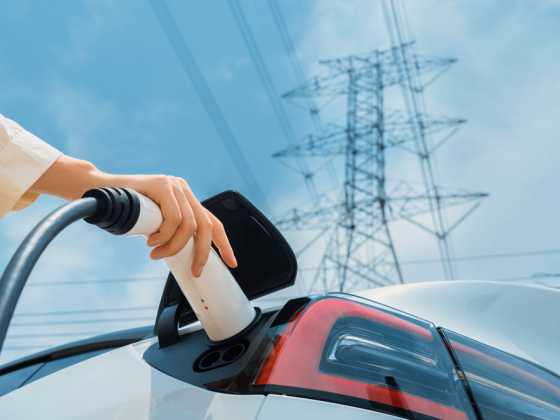Charging fleets ‘on the go’
Denis Naberezhynkh, head of ultra low emission vehicles, TRL, examines how dynamic wireless power transfer has the potential to both reduce HGV fleet emissions and save operators money.
 It will not come as a surprise to fleet managers that the decarbonisation of the UK’s transport sector will require some clever thinking. Indeed, many organisations have already taken up the ultra low emission vehicle challenge, with SMMT figures indicating that almost 50,000 plug-in vehicles are registered in the UK. In addition, there are now more than 5,000 public charging points up and down the country and it is clear that, with a commitment to reducing UK CO2 emissions by 80 per cent by 2050, the roll-out will need to accelerate even further to meet ambitious environmental targets.
It will not come as a surprise to fleet managers that the decarbonisation of the UK’s transport sector will require some clever thinking. Indeed, many organisations have already taken up the ultra low emission vehicle challenge, with SMMT figures indicating that almost 50,000 plug-in vehicles are registered in the UK. In addition, there are now more than 5,000 public charging points up and down the country and it is clear that, with a commitment to reducing UK CO2 emissions by 80 per cent by 2050, the roll-out will need to accelerate even further to meet ambitious environmental targets.
It’s now apparent that meeting emissions targets will not be possible without the substantial adoption of electrified powertrain vehicles. However, while there continues to be a number of perceived barriers to entry for fleets, especially in the HGV sector, technologies such as electrified roads, could provide the solution. Indeed, the current focus on automated vehicles and the discussions around motorway platooning of delivery fleets are particularly relevant in the context of keeping vehicles moving. Google has recently announced its own investigations into wireless charging for its self-driving car, while organisations like Siemens are starting to investigate e-highways that can also electrify HGVs. With trials about to launch in Sweden, it is an interesting time for fleet managers looking at future opportunities.
Exploring on-road charging
Returning to the UK, whether it is managing the impact of the thousands of company car drivers or updating the technology behind the significant number of LCV delivery fleets in our cities, electric vehicles (EV) offer an ideal solution to tackling the current air quality problem. They provide zero tailpipe emissions, as well as grid‑to-wheel CO2 emissions already below most internal combustion engine vehicles. However, current EVs are more appropriate for urban use. Range and utilisation are constrained by battery limitations and charging times, so for longer journeys on strategic roads or outside of cities, EVs are not yet practical.
Research to-date indicates radical battery technology breakthroughs are not anticipated in the near future. At the same time, incremental improvements in EV battery capacity will place additional strain on plug-in charging infrastructure, due to longer charging times and requirements for high power charging for highly utilised or large battery vehicles. Therefore, in order to accelerate adoption, we need to find alternative solutions that overcome the current limitations. One possible solution is the development of a cost‑effective and energy efficient way of providing power to vehicles as they move on the strategic road network. This would not only reduce the need for large, expensive batteries on-board vehicles, but reduce the dependence on plug-in infrastructure, allowing utilisation to be optimised. Indeed, a recently completed feasibility study by TRL into dynamic wireless power transfer (DWPT) suggests that wireless power transfer could be a technology that can help make this concept a reality.
To assess the viability of powering plug-in vehicles on England’s major roads for Highways England, TRL recently completed a feasibility study into DWPT. The study sought to understand whether DWPT technology can be used on England’s strategic roads to prepare for, and potentially encourage, greater take-up of electric vehicles.
How wireless power transfer works
DWPT uses multiple inductive-loops along a stretch of roadway to provide power to vehicles when moving at motorway speeds. Unlike other alternatives, it does not require installation of excessive, over-ground infrastructure and removes the requirement for driver or user interaction, increasing the practicality and user-friendliness of charging.
Results from tests around the world so far indicate that efficiencies of such DWPT systems should be comparable to plug-in charging. Findings from the feasibility study showed that existing DWPT systems have already proven to be able to deliver power of up to 140kW to moving vehicles, with higher levels possible.
Indeed, one of the advantages of DWPT systems is that they are designed to supply power directly to the electric motors in the vehicle, thus avoiding the inefficiencies of battery charging and discharging. It also enables vehicles with very small batteries to cover large distances of equipped highway in a mostly fully electric mode, for example by hybrid HGVs. In such cases, battery range can be reserved for sections not equipped with DWPT or for electric traction in the final stages of the journey, potentially in more urban areas to reduce exposure of people to tailpipe emissions.
The realistic impact of investing in a wireless network
During the feasibility study, two different DWPT system coil layouts were considered, with different power ratings and using actual vehicle flows with assumed DWPT vehicle penetration, to determine the possible average and maximum power demand. Power requirements varied per mile depending on vehicle density and coil arrangements.
However, overall it was found that four 1MVA secondary substations per km should be sufficient to cope with highest possible demand.
Network cost assessments were based on a section of the M6 motorway, due to the fact it had a high vehicle flow and enabled consideration of a worst case scenario for power demand. The results showed that, depending on what asset ownership model is adopted, the cost of a Distribution Network Operator connection could range between £190,000 per km to £425,000 per km.
Combined with the cost of the DWPT equipment and road installation, costs per km are substantial. However, when it is considered that the technology would enable thousands of vehicles each day to drive in full EV mode along the equipped sections of the road, the benefits quickly become apparent.
Findings from the feasibility study showed that over a 20-year period, CO2 emissions could be reduced by 40 per cent on a per km basis, significantly helping the UK to meet the national targets for overall CO2 reduction by 2050.
Furthermore, cumulative CO2 reduction (taking account of CO2 emissions from power generation) could add up to 34,686 tonnes, with a monetised value of almost £2million.
The findings also revealed that NOx and PM emissions could also be reduced, by over 40 per cent and 30 per cent respectively on a per km basis, with reductions in these pollutants on the highway most beneficial near populated or urban areas. Over the 20-year period considered in the study, NOx and PM emissions would be reduced by 55,886 tonnes and 572kg respectively, so the benefits should not be underestimated.
As part of its research, TRL engaged with various road users, including freight and coach operators, and found that most supported the concept of electrified lanes. Stated preference is a difficult thing to assess, but TRL did find that a substantial number of vehicle operators were very interested to further investigate whether something like this could reduce their emissions and save them money.
Developing a user-friendly approach to charging
Wireless power transfer is already a reality across a number of sites in Europe for the static charging of light and heavy duty vehicles; dynamic wireless power transfer takes this technology to the next level. It is not intended to replace the need for plug-in charging, but to provide an additional option for opportunistic charging or powering of the vehicle over long journeys. This should not only make it possible to electrify a much larger proportion of the vehicle fleet, but also to undertake a higher proportion of driving using low-emission and low pollution electric traction.
The prospect of providing power to vehicles on the move offers exciting possibilities. However, in order to be certain of the anticipated performance and benefits, the technology first needs to be extensively trialled in a representative environment before piloting on a public road. If successful, DWPT, together with conventional plug-in charging in selected locations and urban areas, could provide a flexible, user‑friendly and fit-for-purpose charging ecosystem to help achieve the radical step change in vehicle electrification needed to meet longer term air quality and greenhouse gas emission targets.
For fleet managers, especially those operating commercial vehicles, there is significant opportunity in wireless charging. While there are very few options for electrification of HGVs at present, largely due to the high power and energy storage requirements, the concept of road electrification, like DWPT, could help to make near zero emission HGVs more of a reality.
By utilising a combination of hybrid vehicle and electric road technologies, this would allow fleets to significantly reduce fuel costs and emissions.
Not a far-fetched option
Looking forward, there are already electric roads using overhead catenary systems for HGVs being trialled in Sweden and the US. Other European countries, like Germany, France and Norway, are also not far off their own feasibility studies into electric roads for freight vehicles.
This is not a far-fetched option for the future, but an area which switched-on fleet managers should be considering today.
References
1 Committee on Climate Change, 2012 – Cost and performance of EV batteries. Available at http://bit.ly/1J3CiGZ
2 Highways England. 2015. Feasibility Study: Powering electric vehicles on England’s major roads. Available at bit.ly/1HQjBVA
Further Information
bit.ly/1HQjBVA






